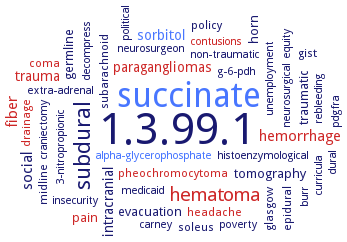1.3.99.1: succinate dehydrogenase
This is an abbreviated version!
For detailed information about succinate dehydrogenase, go to the full flat file.

Word Map on EC 1.3.99.1 
-
1.3.99.1
-
succinate
-
subdural
-
hematoma
-
social
-
hemorrhage
-
fiber
-
intracranial
-
sorbitol
-
paragangliomas
-
trauma
-
horn
-
evacuation
-
pain
-
tomography
-
germline
-
traumatic
-
headache
-
gist
-
drainage
-
policy
-
soleus
-
pheochromocytoma
-
coma
-
subarachnoid
-
midline
-
epidural
-
glasgow
-
medicaid
-
contusions
-
political
-
3-nitropropionic
-
histoenzymological
-
burr
-
neurosurgeon
-
unemployment
-
non-traumatic
-
poverty
-
craniectomy
-
neurosurgical
-
carney
-
equity
-
insecurity
-
alpha-glycerophosphate
-
pdgfra
-
extra-adrenal
-
decompress
-
curricula
-
rebleeding
-
dural
-
g-6-pdh
- 1.3.99.1
- succinate
-
subdural
- hematoma
-
social
- hemorrhage
- fiber
-
intracranial
- sorbitol
- paragangliomas
- trauma
- horn
-
evacuation
- pain
-
tomography
-
germline
-
traumatic
- headache
-
gist
- drainage
-
policy
- soleus
- pheochromocytoma
- coma
-
subarachnoid
-
midline
-
epidural
-
glasgow
-
medicaid
- contusions
-
political
-
3-nitropropionic
-
histoenzymological
-
burr
-
neurosurgeon
-
unemployment
-
non-traumatic
-
poverty
-
craniectomy
-
neurosurgical
-
carney
-
equity
-
insecurity
- alpha-glycerophosphate
-
pdgfra
-
extra-adrenal
-
decompress
-
curricula
-
rebleeding
-
dural
- g-6-pdh
deleted, now included with EC 1.3.5.1, succinate dehydrogenase (quinone)
ECTree
Advanced search results
Results in table 6 Expression 26 General Information 135 PDB ID
Expression
Expression on EC 1.3.99.1 - succinate dehydrogenase
Please wait a moment until all data is loaded. This message will disappear when all data is loaded.
Hfq protein binds NrrF (a Fur-regulated sRNA) and mediates Fur-dependent NrrF regulation of succinate dehydrogenase. NrrF forms a duplex with a region of complementarity within the sdhDA region of the succinate dehydrogenase transcript, and Hfq enhances the binding of this sRNA to the identified target in the sdhCDAB mRNA. This is likely to result in rapid turnover of the transcript in vivo
-
higher content of calcium cations in the nucleus correlates with the lower level of the sdh1-2 gene transcription, regulation, overview
-
transcriptional regulation: the cAMP-dependent regulator GlxR functions as a repressor sdhCAB operon expression
-
transcriptional regulation: the regulator of acetate metabolism RamAas functions an activator of sdhCAB operon expression, whereas RamB has no obvious influence
-
treatment of K-562 cell lines with nicotinamide and kaempferol to inhibit deacetylase activity of SIRT3 and stimulate SIRT3 expression, overview
-
white or red light are down-regulating factors for the mRNA content of the sdh1-2 and sdh2-3 genes and SDH catalytic activity both in wild-type plants and in the mutant deficient in the phytochrome B gene, but not in the mutant deficient in the phytochrome A gene, while the far red light of 730 nm reverses the red light effect
-
ECTree
Advanced search results
| Results | in table |
|---|---|
| 6 | Expression |
| 26 | General Information |
| 135 | PDB ID |
Expression
Expression on EC 1.3.99.1 - succinate dehydrogenase
Please wait a moment until all data is loaded. This message will disappear when all data is loaded.
Hfq protein binds NrrF (a Fur-regulated sRNA) and mediates Fur-dependent NrrF regulation of succinate dehydrogenase. NrrF forms a duplex with a region of complementarity within the sdhDA region of the succinate dehydrogenase transcript, and Hfq enhances the binding of this sRNA to the identified target in the sdhCDAB mRNA. This is likely to result in rapid turnover of the transcript in vivo
-
higher content of calcium cations in the nucleus correlates with the lower level of the sdh1-2 gene transcription, regulation, overview
-
transcriptional regulation: the cAMP-dependent regulator GlxR functions as a repressor sdhCAB operon expression
-
transcriptional regulation: the regulator of acetate metabolism RamAas functions an activator of sdhCAB operon expression, whereas RamB has no obvious influence
-
treatment of K-562 cell lines with nicotinamide and kaempferol to inhibit deacetylase activity of SIRT3 and stimulate SIRT3 expression, overview
-
white or red light are down-regulating factors for the mRNA content of the sdh1-2 and sdh2-3 genes and SDH catalytic activity both in wild-type plants and in the mutant deficient in the phytochrome B gene, but not in the mutant deficient in the phytochrome A gene, while the far red light of 730 nm reverses the red light effect
-


 results (
results ( results (
results ( top
top





